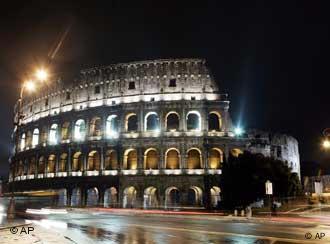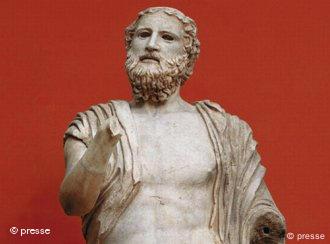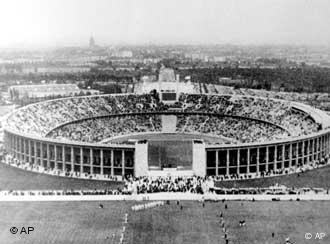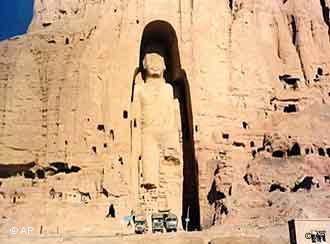Should Nazi Era Sculptures Stay at Berlin's Olympic Stadium?

The following comments reflect the views of our readers. Not all reader comments have been published. DW-WORLD.DE reserves the right to edit for length and appropriateness of content.
The whole stadium was build in that time -- that would mean tear down the whole stadium? By the way these sculptures look more like gay people out of a gay magazine to me. Nothing new and not noticeable at all and one would easily overlook them if none would point with a historical finger to them. Keep them. They are a part of the German history no matter whether we like the history or not. -- Axel Schunn
These statues are depictions of athletes as they are still competing today. They do not bear a swastika or any other nationalistic emblems. To remove and/or destroy them would emanate the Nazis' book burning. -- Olaf Henny

Should the Coliseum in Rome be torn down because thousands upon thousands of Christians were persecuted and massacred there in the most hideous of ways? I think the sculptures should remain right where there are as a historical testimony to a political philosophy which caused the destructions of millions. What might be called for is a plague or some other sign which explains the history surrounding the Olympic Stadium. Again if you remove the statues you may as well remove the entire Stadium since it was built by a Nazi architect and paid for by the NSDAP. No statues, no stadium, no games. -- James E. Heinze
Not included in the discussion was the artistic value of the works. It seems to me that a good deal of junk is piling up around us in the name of "art." Frankly, Karl Albiker's discus thrower and relay racer, illustrated at the beginning of the article, fall into this category. They are not art, but merely technical decoration. Art must speak to the observer as well as from the artist. Great art embodies the sense of beauty, or truth, or injustice, or whatever it is embodying. As an example, in Vincent van Gogh's "The Potato Eaters," the sense of the honesty, the earthiness of the people just oozes from the painting. On the other hand, Albiker's sculptures look like rocks in the form of people. Maybe it's because they aren't doing anything. In fact, it may be a sign of the intellectual bankruptcy of the Nazi regime that they couldn't produce any great art. They could produce large buildings, but nothing that inspires the observer with the sense of wonder. Destroying some Nazi art is no loss. -- Jonathan Miller

I don't think the statues should be destroyed, but I agree with the idea of putting explanatory plaques next to them. They don't seem much different than "ideals of beauty" that we now see as classical art from Roman and Greek periods, do they? -- Patricia Fogarty
When one has been hurt by something as horrific as the Nazi era it is easy to want to shatter any sign or symbol. Growing up black in the US, I know hatred and racism. The fact however is that art allows one to see life and thoughts of those during times that we are not familiar with. Covering up or removing art made to celebrate life would be a joke. It shows that as a race we are not strong enough to handle life. The statues should stay as a reminder to all that hatred and racism never win. -- Ale Herndon, California, US
I think to destroy the statues would be a crime. Yes, they represent a dark past that all would like to forget. But to destroy them would be to me the same as destroying and saying that the concentration camps should be gone because they remind us of a dark time in the world history. In high school, I had a history teacher who said: "If you fail to study history then you are doomed to repeat it." I know it is not original, but it is so true. -- M . Needham
The statues are symbolic of the Nazi era, however they are historical art. Was the artist convicted of war crimes and a known supporter? Or was he perhaps well regarded by the Nazis as an artist and it was in his best interest to cooperate and produce the art? If there are no concrete answers/convictions attached to these questions than the art should stay. -- Peter Schmidhuber
Preserving the truth is always best. Christoph Stölzl had the best idea -- keep them and explain them. Destroying the past is not good, even for those who advocate it. If you go to Charleston, South Carolina, USA, today, you will find the old slave market in the downtown area. Slavery was a horrible tragedy, but it is good that the slave market remains. The same with Auschwitz -- it should remain as a reminder. When you think about the statues in this context, it is quite apparent that they are simply part of Germany's history -- which except for 12 years has been glorious -- and they should stay. -- Wiley Horne, US

I think it is a mistake to remove and/or destroy art created during the Nazi regime. The mentality here is that anyone who created art that was commissioned during this period created "tainted" art. I do not agree with this position. My great-aunt was to create a mural in the city hall of Berlin's Schöneberg district, but the start of the war prevented the work from ever having been created. My aunt was by no means a Nazi, she was an artist. Similarly, the sculptures created during this era reflect the human form. If these were in a public space in the United States there would be calls to cover them because of the nudity. No matter how dark the past was, we need to preserve art. In the case of these statues, they are not adorned with Nazi propaganda. I doubt that the majority of people attending events at the stadium would know that these were created during the Nazi era. -- Albert Greuter
I am in favor of the preservation with the same arguments as Stephan Kramer (from the German Central Jewish council) because I think the Giordano-Rosh kind of exorcism is not compatible with a rational civilized behavior and in addition may have the opposite effect of what they naively intend. The other day I was invited to the home of a Jewish friend in Petropolis, near Rio de Janeiro. I was stunned to see the art deco mixed with Nazi sculptures even including some hardware pieces from the SS. Perplexed I asked him how come that he surrounds him with these kinds of objects. He said: "But I survived and they are dead." His parents fled with him from the island of Rhodes shortly before the whole Jewish population of Rhodes was imprisoned and killed. -- Bert Schroer
The very fact that these statues have remained in public view is just another testament to German ambivalence regarding their past. I say leave the sculptures there, illustrating to the world the persistent insincerity Germany continues to exhibit for their prior heinous activities. -- Kurt Brickner

Art of whatever origins should be respected and understood for what it is: a reflection of a period in time -- whether is a good or a bad period. The Taliban blew up the Mountain Buddahs. It was a horrible thing to do. Art should be viewed with respect , no matter how different our religious or political views. Intolerance was the base for conflict. What can make free nations different from the Nazis and other fanatic group is precisely: tolerance. -- G. M. Rodriguez